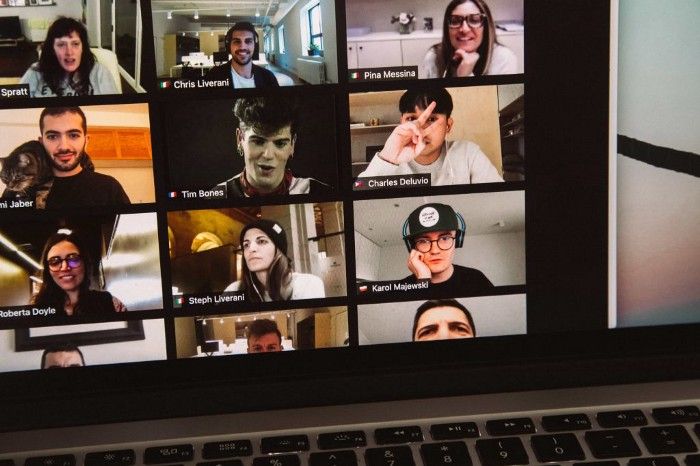Four causes and solutions for ‘Zoom fatigue’

I’m always looking for ways to combat zoom fatigue.
Jeremy Bailenson put out an article in the journal Technology, Mind and Behavior that identifies four characteristics of virtual meetings that lead to exhaustion.
They are:
- Eye Gaze at a Close Distance Keeps our Brains in a Heighten State
- Users Continuously Monitor the Nonverbal Behavior They Send and Receive
- Increased Self-Evaluation from Staring at Yourself
- Constraints on Physical Mobility
Let’s dive into each of these more and talk about their solutions.
Eye Gaze at a Close Distance Keeps our Brains in a Heighten State
If you go into an elevator, what do you do? Do you look down at your phone? Rummage through your bag? Look at your shoes?
I doubt you look straight at the person next to you the whole time. That would be awkward, right?
Well, this is what we do on zoom meetings every day. It’s as if we’re stuck on an elevator staring at each other regardless of who’s speaking.
This puts our brain into one of two heightened modes, prepare for intimacy or for a fight. Since neither of these take place, our brains stay in this heightened mode.
How do you virtually get people out of your personal space?
Solution
The anthropologist Edward Twitchell Hall found that anything less than roughly 2 feet from you is considered your personal space.
For your zoom meetings, an external keyboard can give distance between you and your screen. This is like taking two steps back and will put people your meeting with out of your personal space.
Even though this isn’t mentioned by Bailenson, I believe if you get an external camera and place it 2 feet away, it will remove you from other people’s personal space, which may help subconsciously put them at ease.
Users continuously monitor the nonverbal behavior they send and receive

In real-world settings, not looking directly at the speaker is natural but on a zoom video meeting it could feel rude.
Personally, this finding from Bailenson resonated with me the strongest. My work area is configured with three screens and I always wonder if the person thinks I’m being rude because I’m not looking directly at the camera.
Even though I’m focused on the meeting sometimes I think, maybe I should move my camera so everyone knows I’m not multi-tasking on the sly.
I took some advice from Paula Rizzo and tried to arrange my camera so that I could see the people I was meeting and look directly into the camera simultaneously, but had no luck. It was really awkward looking directly into the eye of the camera and figuring out when to look at the camera vs the screen was too much work.
The only way I found this would work is if the camera was actually right in the middle of my monitor. Hopefully someone is working an invisible camera built into the middle of the monitor.
At the same time, I’m always monitoring for non-verbal feedback, and like Malcolm Gladwell said in the book “ Talking to Strangers” people don’t over exaggerate their emotions like our favorite Friends.
This leads me to seek verbal confirmation because everyone has different levels of expressiveness.
Much like my fear of being rude for not looking at the camera, I sometimes wonder if the person I’m meeting is paying attention to me or something else. If you work with the same people continuously you get an idea of where their screen is vs their camera but you may wonder the first few times.
All these internal thought threads lead to high cognitive load as I’m constantly thinking about the signals I’m sending and searching for positive and negative cues from everyone on the screen.
If you’re like me, how do you free yourself form this cognitive burden?
Solution
Bailenson recommends giving yourself an audio-only break. While I’m a big fan of defaulting to video, as it builds trust, especially with new connections, I have found that once trust is established giving yourself a break from video mentally frees you quite a bit.
There are limits to audio-only though. When debating and deliberating I found that having the video on is a must. People need as much stimulus as possible as to not mis-interpret thoughtful silence as disagreement.
Increased self-evaluation from staring at yourself

When you start a video meeting you get to see all the lovely faces of your teammates and then there’s the one of yourself.
“That’s unnatural” according to Bailenson and I would agree.
It’s like having someone walk around with a mirror pointed at you all day. No thanks.
I’ve been on many video calls where people flat out say “I’m not turning on my camera” or “I’m not camera ready today” and I really can’t blame them.
How do you stop self-evaluating?
Solution
In Zoom there’s the ability to hide your video from yourself which I recommend as it builds trust but you don’t have to see yourself. Of course, only do this if you’re completely comfortable with people seeing you.
MS Teams does not yet have this feature as of March 2021.
Constraints on physical mobility

At the start of 2021 there was a viral TikTok trend of showing off your 2020 weight gain. Since video chatting was one of the main ways we connected with people for work or fun it also meant we were tied to our desk/couch/table for long periods of time.
Before the pandemic, I didn’t get a lot of exercise during physical meetings but there was a lot of natural exercise that just happens during a workday at the office.
Whether it’s walking between meetings, walking to lunch, walking to get coffee or just walking to think, the steps I took were certainly more than the few steps I take from my bedroom to my desk.
How do you naturally get in more steps while being in meetings all day?
Solution
Bailenson recommends people think about how they can change the room they’re in to allow for more mobility while video conferencing. A standing desk is a great start, as sitting too much is linked to many health concerns. I don’t know if changing your room is feasible as space is a premium in cities and many didn’t buy a home thinking “this will be my video-conferencing room”.
Some advice I’ve been personally given is to try to leverage meetings where you’re not speaking as opportunities to turn your camera off and do some light stretching or exercise.
We’re in a hybrid work environment
Even though we’ll get past this pandemic as we’ve gotten past them before, I don’t see a world where everyone rushes back to working in an office everyday.
The benefits of working from home are too great and employers have now learned that their fears of people being less productive when they’re remote is not true.
Much like when we shifted from an agrarian to an industrial society and had to learn different ways of working, we’re now shifting to more of a virtual society where we’ll again need to learn different ways of working well.
If you found this post helpful to your software journey, please subscribe to my newsletter where I talk about my experiences building software for myself, others, and helping aspiring product managers do the same.
